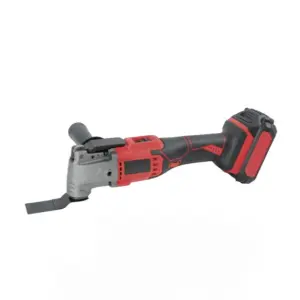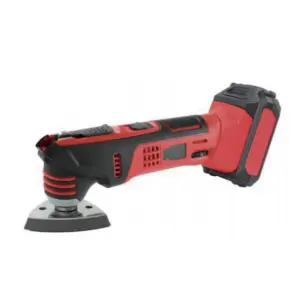Let’s start with the Oscillating Multi Tool
Purpose of Oscillating Multi Tool:
Oscillating multi tools are versatile handheld power tools that are designed for a wide range of cutting, sanding, scraping, and grinding tasks. They are commonly used in woodworking, construction, remodeling, DIY projects, and various other applications. Some common uses of Oscillating multi tools include:
Cutting: Oscillating multi tools can make precise cuts in wood, metal, plastic, drywall, and other materials. They are particularly useful for making plunge cuts, flush cuts, and detailed cuts in tight spaces.
Sanding: With the appropriate sanding attachment, Oscillating multi tools can be used for sanding and smoothing surfaces. They are effective for sanding corners, edges, and irregular shapes.
Scraping: Oscillating multi tools can remove old paint, adhesive, caulk, and other materials from surfaces using scraping attachments. They are useful for preparing surfaces for painting or refinishing.
Grinding: Some Oscillating multi tools come with grinding attachments that allow them to grind and shape metal, stone, and other materials.
Grout Removal: Oscillating multi tools equipped with grout removal blades are commonly used for removing grout between tiles during renovation projects.
How Oscillating Multi Tools Work:
Oscillating multi tools work by oscillating a blade or accessory back and forth at high speed. This oscillating motion allows them to perform a variety of tasks with precision and control. Here’s how they typically work:
Power Source: Oscillating multi tools are powered by electricity (corded) or rechargeable batteries (cordless).
Oscillating Mechanism: Inside the tool, there is a motor that drives an oscillating mechanism. This mechanism causes the attached blade or accessory to oscillate rapidly back and forth.
Quick-Change System: Many Oscillating multi tools feature a quick-change system that allows users to quickly and easily swap out blades and accessories without the need for tools.
Variable Speed Control: Some models have variable speed control, allowing users to adjust the oscillation speed to suit the task at hand and the material being worked on.
Attachments: Oscillating multi tools can accept various attachments, including cutting blades, sanding pads, scraping blades, grinding discs, and more. These attachments enable the tool to perform different functions.
Who are we? Get to know hantechn
Since 2013, hantechn has been a specialized supplier of power tools and hand tools in China and is ISO 9001, BSCI and FSC certified. With a wealth of expertise and a professional quality control system, hantechn has been supplying different types of customized gardening products to large and small brands for over 10 years.
Discover our products: OSCILLATING MULTI-TOOLS
Things To Consider When Buying Oscillating Multi Tool
Motor Power and Speed: The motor speed and power of the device you choose is an important consideration. Generally, the stronger the motor and the higher the OPM, the faster you’ll complete each task. So, start with what kind of work you plan on doing, then go from there.
Battery-powered units typically come in 18- or 20-volt compatibility. This should be a good starting point in your search. You might be able to find a 12-volt option here and there, and it will likely be adequate but aim for an 18-volt minimum as a general rule.
Corded models typically have 3-amp motors. If you can find one with a 5-amp motor, all the better. Most models have adjustable speeds so having a little extra on board if you need it, with the ability to slow things down if you don’t, is the ideal situation.
Oscillation Angle: The oscillation angle of any Oscillating multi tool measures the distance that the blade or other accessory travels from side to side each time it cycles through. In general, the higher the oscillation angle, the more work your equipment does each time that it moves. You’ll be able to remove more material with each pass, potentially speeding up projects and reducing time between accessories.
The range is measured in degrees and varies from around 2 to 5, with most models between 3 and 4 degrees. You likely won’t even notice a difference between a 3.6-degree oscillation angle and a 3.8, so don’t let this one spec be the determining factor for your purchase. If it’s a really low number, you’ll notice the extra time it takes to complete your job, but as long as it’s within the average range, you should be just fine.
Tool Compatibility: The best Oscillating multi tools are compatible with a wide variety of accessories and blade options. Several come with attachments that allow you to hook them up right to a shop vacuum, reducing your dust output and making cleanup even easier. At the very least, you’ll want to make sure that the option you choose is compatible with blades for cutting various materials, plunge cutting blades for when you need that option, and sanding discs for finishing work.
Another thing to consider in terms of tool compatibility is how compatible your multi-tool is with other tools you own. Buying tools from the same ecosystem or brand is a good way to get a longer runtime with shared batteries and reduce workshop clutter. No rule says you can’t have multiple tools from multiple brands, but especially if space is a consideration for you, the same brand might be the best way to go.
Vibration Reduction: The more time you plan on spending with an Oscillating multi tool in your hand, the more important vibration reduction features are going to be. From cushioned grips to ergonomic handles, and even to entire design efforts that minimize vibration, most choices have some vibration reduction baked in. A good pair of gloves mitigates a heavily vibrating machine, but be sure to note vibration reduction tech in the design of any Oscillating multi tool you’re considering.
Additional features tend to jack up the price, so if you’re an occasional user or someone taking on lighter-duty projects with your multi-tool, then vibration reduction might not be worth the added expense. Still, even casual users will appreciate a more comfortable experience and work for longer if the vibration is kept to a minimum. No machine removes all vibration, not in a hand tool anyway, so find one that reduces it if you’re concerned with this at all.
Post time: Apr-25-2024



